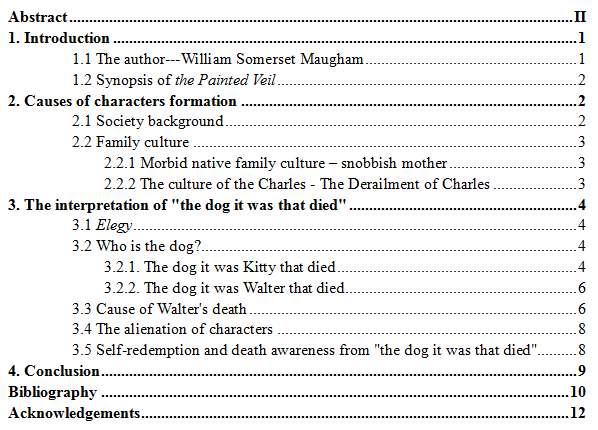
| 文档价格: | 1000金币立即充值 | 包含内容: | 完整论文 | 文章下载流程 | |||||
| 文章字数: | 5234 字 (由Word统计) | 文章格式: | Doc.docx (Word) | 本站文章可以通过查重吗? |
解读《面纱》中“死的却是狗”
The Interpretation of "the dog it was that died" in The Painted Veil
摘要
威廉·萨默塞特·毛姆是英国二十世纪文坛上的一位重要作家, 《面纱》是其以中国为背景创作的长篇小说。本文将采用举例分析和对比论证的方法,从小说中所反映出的人物性格、社会形态以及毛姆小说的创作特点入手,对比历来学者对小说中“死的却是狗”这句话的不同看法:第一种看法是狗所象征的是主人公凯蒂,瓦特作为善人好心收留他,却遭其背叛;第二种是瓦特代表了恶狗并将善良的凯蒂带入人间地狱—湄潭府(一处被瘟疫吞噬的中国小镇)。本文力求从创新的角度来解读这句话在文中所传达的意义,以及其展现出的现代主义中人与人异化的关系,从而造就的人物自我救赎和死亡意识,以期加深读者对小说的全面理解。
关键词:死的却是狗;人物异化;死亡意识;自我救赎
Abstract
William Somerset Maugham is an important writer in the twentieth century British literary world. The Painted Veil is a novel written in the context of China in 1925. This paper will use examples to analyze and contrast the method of argumentation, from aspects of the characters, social form in the novels and Maugham's creative characteristics, compared to different views of scholars on the interpretation of " the dog it was that died": the first view is the dog represents the protagonist Kitty, and Walter is the good man who always takes care of her, but he was betrayed by Kitty; the second is Walter is on behalf of the evil dog and brings Kitty to the hell Mei-tan-fu (a cholera town in China). This paper tries to interpret the meaning of this sentence from the perspective of innovation, as well as analyze the relationship between the humanism and alienation in modernism, so as the self-salvation and death consciousness of the characters, and tries to deepen the readers' understanding of the book.
Key words: the dog it was that died; alienation; self-redemption; death awareness
